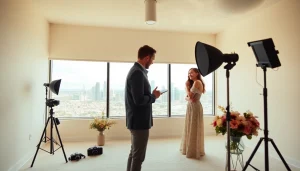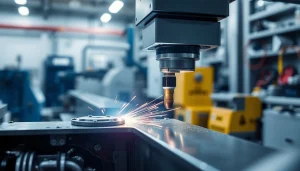Captivating Real Estate Aerial Photography to Elevate Your Listings

Understanding Real Estate Aerial Photography
What is Aerial Photography?
Aerial photography refers to the process of taking photographs from an elevated position, often from drones, helicopters, or planes. This technique captures a bird’s-eye view of landscapes, buildings, and properties, offering unique perspectives that ground-level photography cannot achieve. In real estate, aerial photography is especially valuable, showcasing the full scope of a property, including its surrounding area, access routes, and local amenities. By integrating real estate aerial photography into listings, agents can significantly enhance the appeal of properties and facilitate decision-making for potential buyers.
The Benefits of Aerial Imagery in Real Estate
Aerial imagery provides numerous advantages when marketing real estate. Here are some key benefits:
- Comprehensive View: Aerial photography offers a complete view of the property and its surroundings, enabling prospective buyers to gauge the size and layout effectively.
- Highlighting Neighborhood Features: Aerial images capture local parks, schools, transportation links, and amenities that contribute to the property’s value.
- Creating Visual Impact: Stunning aerial photos grab attention, making listings stand out on popular real estate platforms and social media.
- Showcasing Property Development: For new constructions or large estates, aerial photography can illustrate progress and zoning, appealing to developers and investors.
Different Types of Aerial Photography Techniques
In real estate, several aerial photography techniques can be employed to maximize visual appeal:
- Drone Photography: The most popular method among real estate professionals, drones are user-friendly and can capture high-resolution images from various angles and altitudes.
- Helicopter or Plane Photography: Ideal for larger properties or areas, aerial shots from a helicopter or plane can provide expansive views and context that drones may not be able to achieve.
- 360-Degree Photography: This technique allows viewers to experience virtual tours of the property from all angles, enhancing viewers’ engagement and interest.
- Mapping and Surveying: Utilizing aerial imagery for mapping purposes, real estate agents can offer detailed insights regarding land use and property boundaries.
Choosing the Right Equipment for Real Estate Aerial Photography
Essential Drone Features for Real Estate Shooting
When selecting a drone for real estate aerial photography, consider these essential features:
- Camera Quality: Look for drones equipped with high-resolution cameras (at least 12MP). Full-frame cameras offer the best quality, but a good quality 4K camera can also deliver stunning results.
- Stability and GPS: A drone with excellent stability features and GPS functionality will ensure accurate and sharp images even in windy conditions.
- Flight Time: Depending on the size of the property, a drone with at least 20-30 minutes of flight time is essential for capturing all necessary angles without needing frequent recharges.
- Obstacle Avoidance: Drones with obstacle detection help prevent accidents during flights in complex environments.
Camera Settings for Stunning Aerial Shots
Optimal camera settings are crucial for capturing breathtaking aerial shots:
- ISO: Keep the ISO low (100-200) for clearer images; higher ranges may introduce noise.
- Aperture: A mid-range aperture (f/5.6 to f/8) provides a good depth of field, making the entire scene sharp.
- Shutter Speed: A fast shutter speed (1/500 or faster) can capture moving elements, such as cars or people, without blurring.
- White Balance: Set the white balance according to the lighting conditions (Sunny, Cloudy, etc.) to ensure true-to-life colors.
Accessories to Enhance Your Aerial Photography
In addition to the drone, several accessories can enhance your aerial photography experience:
- Extra Batteries: Always have spare batteries on hand to extend your shoot time.
- ND Filters: Neutral density filters can help achieve cinematic shots by reducing glare and the impact of bright sunlight on your images.
- Carrying Case: A sturdy case protects your equipment and facilitates travel.
- Smartphone/Tablet: Use a mobile device to access drone controls easily and get live previews of your shots.
Best Practices for Capturing Real Estate Aerial Shots
Timing and Lighting Considerations
Lighting can make or break an aerial photograph. Here are some tips for optimal timing and light conditions:
- Golden Hour: The hour after sunrise and before sunset provides the most favorable light for photography, offering soft shadows and warm tones.
- Avoid Midday Sun: Harsh overhead lighting can lead to overly bright highlights and deep shadows, compromising image quality.
Composing Your Aerial Photographs
Composition is key in aerial photography. Consider these strategies:
- Rule of Thirds: Position key features along the grid lines or intersections of a third to create balance and interest.
- Leading Lines: Utilize roads, pathways, or fences to guide the viewer’s eye through the photograph.
- Variety of Angles: Capture shots from different altitudes and angles to provide a fuller story of the property.
Post-Processing Tips for Real Estate Images
Post-processing is crucial for enhancing aerial images. Here are some recommended practices:
- Color Correction: Adjust brightness, contrast, saturation, and color balance to make images pop.
- Crop and Straighten: Remove distractions and straighten horizons to create a polished final output.
- Sharpening: Apply light sharpening to enhance details, but avoid overdoing it to prevent unnatural looks.
Marketing Your Real Estate Aerial Photography Services
Creating an Impressive Portfolio
Your portfolio is your key marketing tool. Here’s how to create a standout collection:
- Diverse Shots: Include a variety of properties, drone angles, and seasonal images to showcase your versatility.
- Before and After: Showcasing the contrast between traditional images and aerial shots highlights the value of your services.
- High-Quality Images: Ensure that each image in your portfolio is of the highest quality—your work is a reflection of your professionalism.
Effective Strategies for Attracting Clients
To attract clients for your aerial photography services, consider these strategies:
- Networking: Attend real estate events, expos, or local open houses to connect with potential clients and showcase your work.
- Collaborate with Real Estate Agents: Partner with agents who can help promote your services to their clients.
- Offer Promotions: Provide limited-time discounts or package deals to encourage first-time clients to try your services.
Leveraging Social Media to Showcase Your Work
Social media can be a powerful tool for reaching your target audience. Follow these tips to maximize your presence:
- Visual Platforms: Focus on visually-driven platforms like Instagram and Pinterest to display your high-quality aerial imagery.
- Consistent Posting: Regularly update your profiles with new work, engaging content, and behind-the-scenes peeks at your process.
- User Engagement: Actively interact with followers by responding to comments and messages to build rapport and trust.
Measuring Success in Real Estate Aerial Photography
Key Metrics to Track for Client Satisfaction
Measuring success in your aerial photography business goes beyond just taking great photos. Keep track of these metrics:
- Client Feedback: Collect testimonials and feedback to gauge satisfaction, which can provide insight into areas for improvement.
- Repeat Business: Monitor how frequently clients return for additional services, indicating satisfaction and trust in your work.
Analyzing Engagement and Conversion Rates
Understanding engagement metrics for your marketing efforts is crucial:
- Website Analytics: Use tools like Google Analytics to track visitor behavior on your portfolio page.
- Social Media Insights: Analyze your engagement rates—likes, shares, and comments—to understand what content resonates with your audience.
Adapting Your Approach Based on Feedback
Continuous improvement is vital for long-term success. Consider these ways to adapt:
- Adjust Services: Based on client feedback, be open to adjusting the types of services you offer to better meet demand.
- Update Techniques: Stay informed on the latest trends and technology in aerial photography to keep your offerings fresh.
- Regular Training: Invest in workshops or courses to refine your skills and stay up-to-date on new techniques and equipment.





